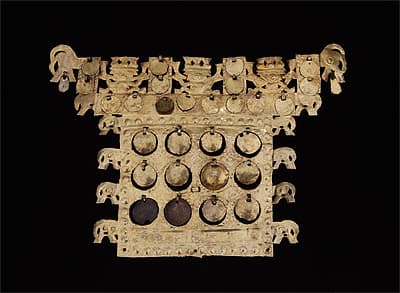SICÁN-LAMBAYEQUE culture North coast 750 – 1375 AD
Pectoral 900-1100 AD gold16.7 (h) x 25.5 (w) cm Ministerio de Cultura del Perú: Museo Arqueológico Nacional Brüning, Lambayeque Photograph: Daniel Giannoni
Many kinds of gold objects were made for the Sicán elite, for decorative, ceremonial and funerary purposes. Pieces of armour such as the breastplate or plastron were possibly used for ritual purposes, but probably were made solely to accompany the noble dead. The work is decorated with abstract motifs rather than the more common figures of the Lord of Sicán or birds (see cats 110–113, 115, 129). Blank and patterned fields alternate between studded and granulated borders. The meaning of the ornamentation—large embossed double scrolls with crowns—is no longer decipherable.
The ornate pectoral for a high-ranked noble or priest was made to sew onto clothing. Elaborate elements such as animal heads, two on top and four down each side, are cut and affixed, with three crowned figures above. Discs of cut gold dangle in circular holes, attached at the top. In the banner decoration, rows of pendants on each side would tinkle as they moved. The double sheets may have formed part of a standard. Like all such luxurious objects, they were used to accentuate the wealth and power of their owners, separating them from the artisans, farmers and herders whose labour underpinned the extraordinary lives and burials of the rulers.
Christine Dixon
Many kinds of gold objects were made for the Sicán elite, for decorative, ceremonial and funerary purposes. Pieces of armour such as the breastplate or plastron were possibly used for ritual purposes, but probably were made solely to accompany the noble dead. The work is decorated with abstract motifs rather than the more common figures of the Lord of Sicán or birds (see cats 110–113, 115, 129). Blank and patterned fields alternate between studded and granulated borders. The meaning of the ornamentation—large embossed double scrolls with crowns—is no longer decipherable.
The ornate pectoral for a high-ranked noble or priest was made to sew onto clothing. Elaborate elements such as animal heads, two on top and four down each side, are cut and affixed, with three crowned figures above. Discs of cut gold dangle in circular holes, attached at the top. In the banner decoration, rows of pendants on each side would tinkle as they moved. The double sheets may have formed part of a standard. Like all such luxurious objects, they were used to accentuate the wealth and power of their owners, separating them from the artisans, farmers and herders whose labour underpinned the extraordinary lives and burials of the rulers.
Christine Dixon
Many kinds of gold objects were made for the Sicán elite, for decorative, ceremonial and funerary purposes. Pieces of armour such as the breastplate or plastron were possibly used for ritual purposes, but probably were made solely to accompany the noble dead. The work is decorated with abstract motifs rather than the more common figures of the Lord of Sicán or birds (see cats 110–113, 115, 129). Blank and patterned fields alternate between studded and granulated borders. The meaning of the ornamentation—large embossed double scrolls with crowns—is no longer decipherable.
The ornate pectoral for a high-ranked noble or priest was made to sew onto clothing. Elaborate elements such as animal heads, two on top and four down each side, are cut and affixed, with three crowned figures above. Discs of cut gold dangle in circular holes, attached at the top. In the banner decoration, rows of pendants on each side would tinkle as they moved. The double sheets may have formed part of a standard. Like all such luxurious objects, they were used to accentuate the wealth and power of their owners, separating them from the artisans, farmers and herders whose labour underpinned the extraordinary lives and burials of the rulers.
Christine Dixon


